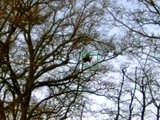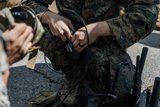Rafael enhances Drone Dome with CRFS's RFeye technology
The CRFS RFeye sensor has been integrated with Rafael's Drone Dome. (Photo: Rafael)
CRFS’s RFeye RF technology has been successfully integrated as sensor option into Rafael’s Drone Dome, a C-UAS system in service with the UK MoD and ordered for an undisclosed Asian customer.
It was reported that Drone Dome was used in 2021 to protect world leaders during the G7 Summit in Cornwall, England from uncrewed aerial threats.
Rafael reports that on behalf of a European-based NATO partner it approached CRFS to enhance Drone Dome's RF detection and geolocation capability by integrating RFeye technology. CRFS has headquarters in Cambridge, UK and in the US.
Related Articles
Paris Air Show: Rafael showcase Drone Dome laser capability
UK selects Rafael’s Drone Dome
Rafael’s Drone Dome intercepts targets with new laser technology
The RFeye receiver is designed to offer RF performance in a rugged and simple deployment, with detection, geolocation and data filtering/streaming services through an open application programming interface.
In August 2018, after a demonstration in February of the same year, the UK MoD awarded an urgent capability requirement contract for a C-UAS capability to Rafael in a deal worth £7.6 million ($9.97 million).
Drone Dome is made up of three main components: RADA's RPS-42 radar subsystem, Controp's MEOS observation subsystem and Netline's C-Guard RD & NetSense subsystem.
The radar's detection range of 16km also works against a minimum target size of 0.002m² at 3.2km. Up to four radars can be arranged to ensure full 360º azimuth and 90º elevation coverage. The operator can detect targets as soon as the remote control is turned on.
When a threat enters the neutralisation area, a mobile directional jammer blocks all VHF, UHF, ISM, GPS and Wi-Fi links across the 20-6,000MHz frequency ranges. As the jammer covers about 70º, it avoids interfering with UAVs operating in permitted areas.
Related Equipment in Defence Insight
More from Digital Battlespace
-
![Australia looks towards space with force restructure, investment and training]()
Australia looks towards space with force restructure, investment and training
Australia is looking to improve its presence in space with a focus on communications and creating a dedicated segment of its defence forces committed to the domain.
-
![EID to unveil new vehicle communication system at DSEI]()
EID to unveil new vehicle communication system at DSEI
The Portuguese company’s naval communications system is in service across more than a dozen countries. It has turned to its home nation for support in developing a new vehicle based C2 system.
-
![Chess Dynamics successfully demonstrates Vision4ce AI-driven tracker]()
Chess Dynamics successfully demonstrates Vision4ce AI-driven tracker
The Vision4ce Deep Embedded Feature Tracking (DEFT) technology software is designed to process video and images by blending traditional computer vision with artificial intelligence (AI) algorithms to present actionable information from complex environments.
-
![Wave Relay devices cleared for security use on commercial systems in industry trend]()
Wave Relay devices cleared for security use on commercial systems in industry trend
Persistent Systems has been cleared by National Security Agency (NSA) to transmit sensitive data on commercial networks. The devices are added to the NSA’s Commercial Solutions for Classified (CSfC) component list which also includes other companies’ products providing the same security.
-
![UK teases cyber spending boost in Strategic Defence Review ahead of “imminent” release]()
UK teases cyber spending boost in Strategic Defence Review ahead of “imminent” release
The release of the UK’s Strategic Defence Review (SDR) has been long promised as mid-year. It is possible it could be as early as 2 June although the UK Ministry of Defence (MoD) continues to play its cards close to its chest.
-
![Intelsat emphasises SATCOM resilience for SOF in contested domains (video)]()
Intelsat emphasises SATCOM resilience for SOF in contested domains (video)
Intelsat outlines how its multi-orbit SATCOM architecture is enhancing connectivity and resilience for special operations forces operating in degraded and contested environments.

























